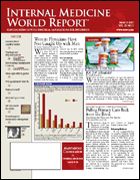Publication
Article
Internal Medicine World Report
Ozone Levels Linked to Increased Mortality Rates in 3 Independent Studies
Ozone Levels Linked to Increased Mortality Rates in 3 Independent Studies
smilar conclusions linking daily levels of ozone pollution to an increased risk of death—particularly in the summer months—have been reached by 3 independent studies published in the journal Epidemiology. All 3 meta-analyses were conducted to assess whether death rates increase on days when levels of ozone pollution are high, and if so, by how much. Michelle L. Bell, MSE, PhD, of Yale University, New Haven, Conn, and colleagues found a significant short-term relationship between ozone and mortality rates using 2 different data sets (Epidemiology. 2005;16:436-445). The effect was particularly strong for cardiovascular and respiratory causes of death, elderly people, and same-day ozone levels. For each 10-ppb increase in daily ozone level, the total death rate for that day and the 2 follow-ing days increased by 0.87%. This relationship
remained consistent after adjusting for additional factors, including levels of particulate
pollutants. A similar increase of 0.86% per 10 ppb was reported by Jonathan I. Levy, PhD, of the Harvard School of Public Health, Boston, and colleagues (Epidemiology. 2005;16:458-468). A smaller overall effect of ozone on death rates was reported by Kazuhiko Ito, PhD, of New
YorkUniversity, and colleagues, but they concurred that the main effect occurred
during the summer months (Epidemiology. 2005;16:446-457). Analysis of data from
23 geographic locations worldwide confirmed a relationship between ozone and
mortality in all but 5 regions. The relationship was strongest in Brisbane, Australia, and Mexico City, where ozone levels remain fairly constant throughout the year. Commenting on these data in the same issue (pages 427-429), David V. Bates, MD, of the University of British Columbia,
Vancouver, Canada, noted that the associations between ozone levels and total mortality
in these 3 studies “point to the urgent need to reduce public exposures to ambient
ozone by all possible means.” In a second editorial (pages 430-435), Steven N. Goodman, MD, MHS, of the Department of Oncology, P ediatrics, Epidemiology, and Biostatistics, Johns Hopkins School of Medicine, Baltimore, Md, wrote that the bottom lines in all 3 studies are “remarkably consistent, within a fraction of a percent.” However, he also pointed to weaknesses
in some of the statistical methods, especially the use of pooled data from many singlesite
studies. A 14-year follow-up study of air quality from 95 US cities suggests that
ozone’s effect on death rates may be smaller, although still significant, he noted,
adding that large, multisite studies areneeded to provide the data required for
more definitive conclusions on the health risks of ozone.
